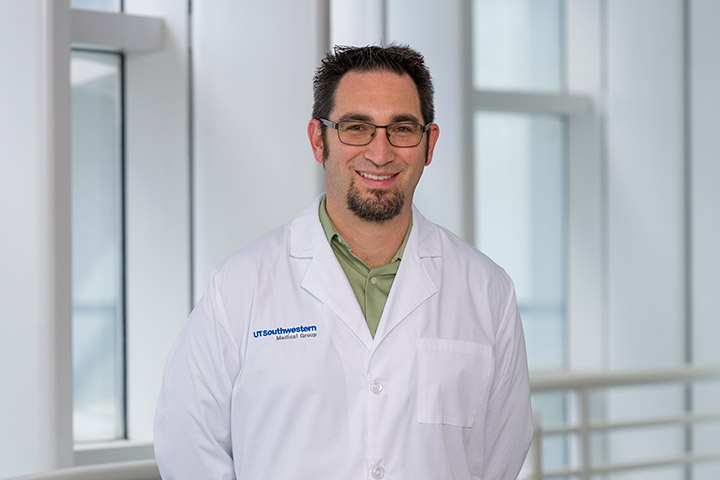For Pancreatic Cancer Patients, Pain Control Through Targeted Radiotherapy

Helping to control cancer pain is as much art as it is science.
What works for one patient may not work as well for another. Unfortunately, pain remains a major issue for patients with cancer, and some research shows that as many as 30 to 50 percent of all cancer patients experience moderate to severe pain, which can negatively affect quality of life, ongoing treatment, and potentially length of survival. For pancreatic cancer patients, pain management can include anti-inflammatory medications, opioids, and narcotics, as well as surgical or radiological interventions. But more needs to be done. That’s why physician-scientists across the globe are looking at better ways to manage cancer pain.
“While many (pancreas cancer) patients are well managed with small doses of narcotics (or other modalities) there is a significant proportion of patients that suffer dreadful pain,” explains Dr. Yaacov Lawrence, Director of the Center for Radiation Oncology at Sheba Medical Center in Tel Aviv, Israel. Lawrence is leading a multinational trial that uses targeted radiation directed at the celiac plexus. The goal of the study is not only to relieve pain symptoms, but also to decrease the use of opioids and improve quality of life.
About Celiac Plexus Radiotherapy
The procedure being studied by Lawrence and colleagues is called celiac plexus radiotherapy. The celiac plexus, also called the solar plexus, is located in the pit of the stomach, just in front of the aorta, the body’s main artery. It is comprised of a network of radiating nerve bundles (hence “solar”) that play a role in the function of the stomach and liver as well as other organs. Pancreatic cancer and other gastrointestinal cancers can produce severe pain, especially back pain, by pressing upon and infiltrating the nerves of the celiac plexus. One current approach to pancreatic cancer pain management is called a celiac block, in which doctors inject a local anaesthetic around the nerves in the lower back. But the efficacy of this procedure is variable, and published results have been disappointing, Lawrence says.
The new approach—celiac plexus radiotherapy—stemmed from the hypothesis that ablative radiation targeted to the celiac plexus could potentially alleviate pain. With stereotactic ablative radiotherapy, also known as stereotactic body radiation therapy (SBRT), doctors employ very high doses of precisely-targeted radiation using different radiation beams of varying intensity. Treatments are typically given in a single dose. The goal: destroy the cancer and minimize radiation’s effect on healthy tissues.
Targeting the celiac plexus with this form of radiation is novel. “The celiac plexus has not been targeted using radiation and our approach is quite distinct, since we deliver a very high dose of radiation to the length of the celiac plexus, which is around 11 cm,” Lawrence notes, adding that for many patients this appears to achieve long-lasting pain relief since the entire length of the nerves is treated rather than just one area.
Like many new ideas in science, the hypothesis for celiac plexus radiotherapy came about through a combination of curiosity and open-mindedness, with a little dose of happenstance. “About seven years ago we started doing SBRT for pancreatic cancers, and I had one patient referred to me with a post-Whipple tumor bed recurrence,” Lawrence explains. He treated the patient with SBRT, hoping to achieve disease control, and admits he didn’t consider a side effect of pain control. “I was very surprised when the patient came to me during treatment to tell me how much better he was feeling, and that his pain had improved,” he says. “Not everyone had such a good palliative response to SBRT and I wondered if there was a way to optimize the technique. So I brainstormed with my Chair, Professor Zvi Symon, and we thought that maybe the celiac plexus was the correct target as opposed to the tumor itself. After that we had to devise the technique and generate pilot data, and that became the preliminary data for the current study.”
Early Work Shows Promise
Results of a single-arm prospective clinical study presented at both the American Society of Clinical Oncology (ASCO) and American Society for Radiation Oncology (ASTRO) annual meetings and published in abstract form in both the International Journal of Radiation Oncology and the Journal of Clinical Oncology, showed a reduction in pain and opioid usage as well as an improvement in quality of life after celiac plexus radiotherapy. As part of the study, 21 patients with upper abdominal malignancies (86 percent with pancreatic cancer) were evaluated, all of whom suffered severe lower back pain radiating to the epigastrium, the part of the abdomen located just over the stomach. This pain is thought to be caused by involvement of the celiac plexus. Patients in the study had significant pain despite opioid usage.
In the study, 19 patients received a single fraction of 25 Gy—a very highly- concentrated dose of SBRT in one treatment—while two patients received 45 Gy over the course of five treatments. The primary endpoint of the study was pain relief at three weeks post-treatment, measured using a numerical rating scale. Secondary endpoints included pain at six weeks, analgesic use, and toxicity. Pain that caused problems with daily activities was measured before and after treatment. Analgesic use was not restricted.
The researchers found that all but one patient involved in the study reported a decrease in celiac pain at three and six weeks post-treatment. Of the study cohort, seven patients reported a complete elimination of pain. Patients also reported a decrease in the use of morphine and an improvement in quality of life measures, including enhanced well-being, better sleep quality, and an improvement in carrying out daily activities.
Lawrence emphasizes this approach is complementary to other established pain management techniques, so someone who has had a previous nerve block with pain recurrence can undergo celiac plexus radiotherapy, as well as the reverse. Although some patients have reported completely stopping opioid medication after the procedure, a realistic goal is to decrease dosages, rather than eliminate dosages, he adds. Results of this trial showed that patients needed an average of four daily doses of short-acting opioids for breakthrough pain prior to celiac plexus radiotherapy, and just one daily dose after treatment.
A Look to the Future
Like many physician-scientists involved in pancreas cancer research and treatment, Lawrence believes better outcomes will stem from multimodality care. “This is my opinion, rather than standard of care, but I think all resectable pancreas cancer patients should receive neoadjuvant treatments, for instance a chemo-radiation therapy combination as shown in the PREOPANC study, followed by postoperative chemotherapy like FOLFIRINOX,” Lawrence says. “The Holy Grail would be a nontoxic systemic treatment, but unfortunately that doesn’t yet exist.”
He is excited about the potential for celiac plexus radiotherapy to improve the lives of patients, and is humbled by the support the trial has received. “Designing and running a trial likes this requires a vast amount of goodwill from many people and many professionals worldwide,” he says. “This isn’t a drug company-sponsored trial, there are no financial incentives to take part, there is no patent and no possibilities of commercialization, and yet many academic physicians and their overworked teams across the globe are opening up the trial, all in order to help improve the quality of life of patients.”
He also credits Sheba’s radiation oncology team and medical oncology colleagues, including Dr. Talia Golan, principal investigator of the POLO study recently published in the New England Journal of Medicine. Golan is head of the Sheba Pancreatic Cancer Center.
Information About the Trial
The aim of the current trial is to recruit 100 adult patients with severe, poorly- controlled lower back/abdominal pain thought to originate in the celiac plexus. Study participants will undergo a simulation (a CT scan that takes about one hour), treatment (about 25 minutes, a single fraction of high-dose radiation), and two post-treatment assessments of pain levels and side effects, which can include minor fatigue and possible nausea on the day of treatment and the day following treatment. Some patients have reported a slight worsening of the pain for a few days post-treatment (a pain flare) before noticing pain improvement, Lawrence says.
Currently, Princess Margaret Cancer Centre (Toronto, Canada), The James—The Ohio State University Comprehensive Cancer Center (Columbus), Mount Sinai Hospital (New York), and Sheba are recruiting patients. Additional centers in Europe and Australia are expected to join. The trial is supported by Gateway for Cancer Research.






